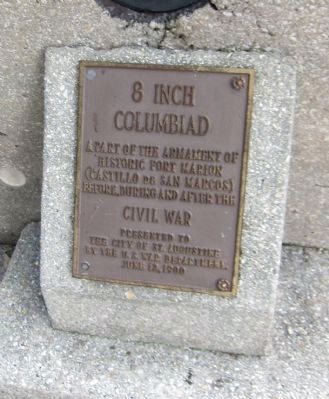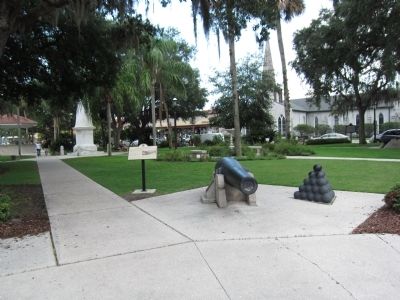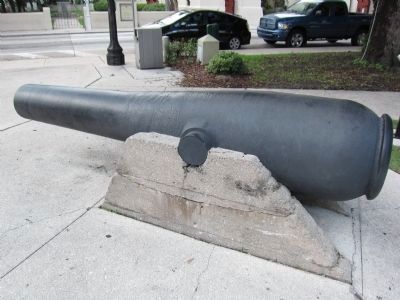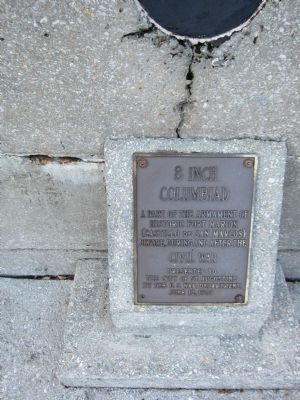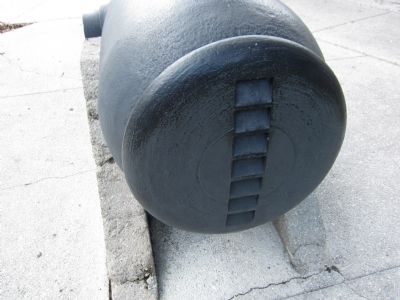Historic District in St. Augustine in St. Johns County, Florida — The American South (South Atlantic)
8 inch Columbiad
A part of the armament of historic Fort Marion (Castillo de San Marcos) before, during and after the Civil War
Presented to the City of St. Augustine by the U.S. War Department
June 12, 1900
Topics. This historical marker is listed in this topic list: War, US Civil. A significant historical month for this entry is June 1857.
Location. 29° 53.555′ N, 81° 18.761′ W. Marker is in St. Augustine, Florida, in St. Johns County. It is in the Historic District. Marker is at the intersection of Cathedral Plaza and St. George Street, on the left when traveling west on Cathedral Plaza. Located in the Plaza de la Constitución. Touch for map. Marker is at or near this postal address: 42 King St, Saint Augustine FL 32084, United States of America. Touch for directions.
Other nearby markers. At least 8 other markers are within walking distance of this marker. Plaza de la Constitución (here, next to this marker); Government House: Legacy of Authority (here, next to this marker); Balcón de los Reyes (a few steps from this marker); Constitution Monument (a few steps from this marker); Andrew Young Crossing (a few steps from this marker); Coquina in These Walls (a few steps from this marker); Cathedral Basilica of St. Augustine (within shouting distance of this marker); Government House and the Plaza (within shouting distance of this marker). Touch for a list and map of all markers in St. Augustine.
More about this marker. The plaque is likely in error. These guns were not part of Fort Marion's armament before the Civil War (the date of manufacture rules that out). The columbiads were part of a batch produced for the Confederacy early in the Civil War.
According to reports, the fort contained only 8-inch howitzers (which are still at the fort today) and 32-pounder smoothbore guns, when recaptured by Federals in March 1862. The Federals may have captured the columbiads elsewhere and moved them to Fort Marion for safe-keeping.
Clearly the cannons were at Fort Marion after the war. However, their use by the Army after the war would be limited. The elevation system would require pre-Civil War carriages. Further, the guns were not constructed in the manner used by the regulation Federal 8-inch guns, and would be suspect when firing full charges.
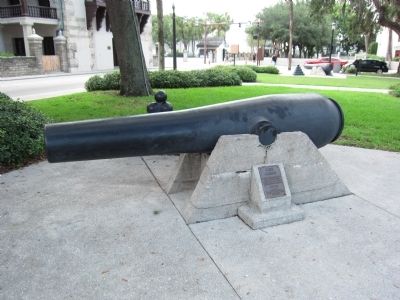
Photographed By Craig Swain, August 1, 2011
4. Second 8-inch Columbiad
Like its mate, this columbiad came from Bellona Foundry in 1861. Marks indicate its registry number as 27 with a weight of 8750 pounds. Also like the other columbiad, this cannon likely was not in St. Augustine before or during the Civil War.
Credits. This page was last revised on April 18, 2023. It was originally submitted on September 3, 2011, by Craig Swain of Leesburg, Virginia. This page has been viewed 1,138 times since then and 38 times this year. Photos: 1, 2, 3, 4, 5, 6. submitted on September 3, 2011, by Craig Swain of Leesburg, Virginia.
